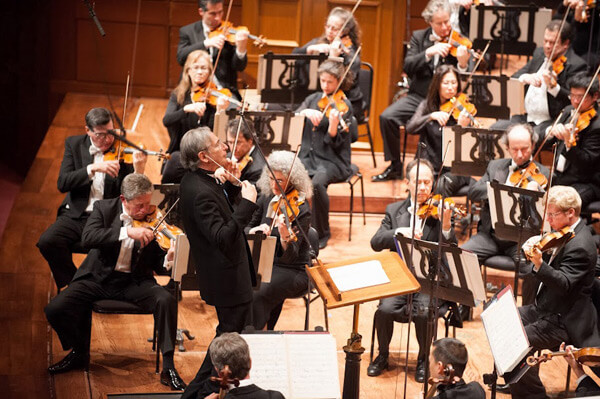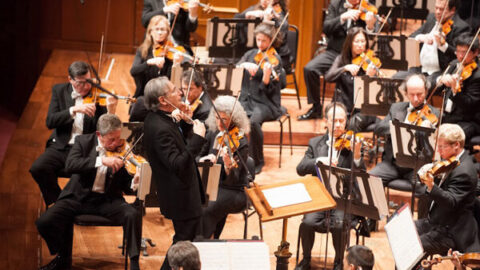 The San Francisco Symphony’s Centennial Season has featured many interesting events, notably lengthening the travel itineraries for six of the top Orchestras nationwide for San Francisco stops to celebrate its big year. However, a homegrown element of the celebratory Centennial has been a re-birth of Michael Tilson Thomas’ American Mavericks festival, which last ran in 2000. The series as a whole will likely prove to test the ‘Mavericks’ ideal, and tonight’s program proved a perfect example of how the conservativism of Orchestras in a middling economy can affect a festival’s message and meaning, yet how clever programming can still yield a unique evening.
The San Francisco Symphony’s Centennial Season has featured many interesting events, notably lengthening the travel itineraries for six of the top Orchestras nationwide for San Francisco stops to celebrate its big year. However, a homegrown element of the celebratory Centennial has been a re-birth of Michael Tilson Thomas’ American Mavericks festival, which last ran in 2000. The series as a whole will likely prove to test the ‘Mavericks’ ideal, and tonight’s program proved a perfect example of how the conservativism of Orchestras in a middling economy can affect a festival’s message and meaning, yet how clever programming can still yield a unique evening.

This opening concert focused on first honoring the fundamental pillars of American music – Charles Ives and Aaron Copland, with some Lou Harrison sprinkled in for Left Coast spice. It follows the traditional orchestra concert program model without a fault – a short opener (Copland’s ‘Orchestral Variations’), a Concerto (Lou Harrison’s Concerto for Organ with Percussion Orchestra), and after an intermission, a Symphony (Charles Ives’ ‘A Concord Symphony’). The peculiar aspect of this concert is that the bookends are both orchestral arrangements of piano solo works – one by the composer himself nearly 30 years after the fact (Copland), and one done posthumously (Ives, via Henry Brant). Seeing how these pieces were realized for orchestra (not to mention the delightful and oddball orchestration of the Harrison concerto) led to a far more engaging and bold program than one might have presumed beforehand.
Copland’s ‘Orchestral Variations’ was easily the most surprising of the evening, sounding unfamiliar in almost every respect we associate him. While the Orchestral Variations’ are based on his atonal and biting 1930 ‘Piano Variations’, they strangely enough distance themselves even from Copland’s singular original when orchestrated. Ultimately, one finds themselves listening to Copland’s color choices and orchestration more than his pitch material – an effect one is hard-pressed to achieve even on as wide-ranging an instrument as the piano. Instead of hearing Copland, we hear a surprisingly eclectic sound world, switching from Mahlerian romantic expressivity one moment to Webern-like creepy pointillism the next, with a little Bernstein ‘West Side Story’ jauntiness thrown in for bizarre measure. While this collage keeps the audience on its toes, the divergent styles seemed to come and go at will, ultimately leaving listeners unable to clearly hear the divisions of the sections. Instead of showing a wide range of orchestration in his ‘Variations’, Copland instead comes off as a slight schizophrenic in this work, even more than one would expect considering the 22 sections he crams into a mere 11 minutes of musical material. Still, it shows a restless side of Copland too little seen in his monochromatic ‘Americana’ pieces, and is definitely a curiosity worth experiencing.

Lou Harrison’s ‘Concerto for Organ with Percussion Orchestra’ was another kaleidoscopic work in the program, and one that greatly impressed, showing a wide range of musical textures and moods while employing a variety of brilliant combinations of organ, piano, and mallet percussion. The 5-movement form echoes Bartok’s symmetrical ‘arch form’, and is elegantly applied in this piece to form a coherent whole while allowing room for contrasting material. Harrison even borrows Bartok’s penchant of giving the third movement the most special and delicate music of the work, employing slow scalar lines and organ pedals for a serene-yet-haunting effect. From the first movement’s fun Gamelan meets Western keyboards vibe, through the second movement’s creepy broken-Halloween-toy solo organ melody, to the dissonant yet gleeful cluster-filled finale that can only be described as a Ferris wheel spinning out of control, the piece was a diverse and absorbing ride from start to finish.

Last on the program was Charles Ives’ ‘A Concord Symphony’, arranged by Henry Brant. Ives never wrote a ‘Concord Symphony’, although his ‘Concord Sonata’ for solo piano, which this work is an arrangement of, is considered one of his greatest masterworks. Henry Brant does a brilliant job orchestrating the material, often finding and separating many beautiful musical lines that can get buried in Ives’ sometimes muddy and dense original. However, the work suggests a certain paradox in attempting such an endeavor, which is that Ives himself would have never been able to orchestrate this work as cleanly and clearly as Brant has done here – and one isn’t sure if he’d want to even if he could. Ives is not about making listening easy; he always was probing how instruments and people don’t always play in tune, or in time, or together in the real world. Music is often sloppy, messy, and filled with clashing overtones and quarter-tones and things that don’t ‘behave’ (church bells, for one), and Ives was damned sure not going to try and pretty it up. For him, the dirtiness was the magic of it – the amateur musician was the authentic realization of the spirit of music-making, not the ‘clean’ professional sound. Hence, when a top-notch orchestra performs a super-polished orchestration of an Ives work, it strikes one as a different sort of piece, almost un-Ivesian in a way.
This feeling lingers until Ives’ brash and unmistakable patriotic bravado dominates in the raucous and stunning second “Hawthorne” movement, which Brant orchestrates so entertainingly and convincingly it could be a standalone concert opener in the orchestral repertoire. However, in spite of a strong third movement, the remarkable flute solo near the end of the fourth “Thoreau” movement is greatly missed in the symphonic arrangement. With so many instruments and timbres in use throughout the work, Brant seemingly ran out of paint on his symphonic easel to make this amazing color change in the original Sonata a special moment in his arrangement. As such, the piece – despite doing a great deal of good throughout – ends on a slightly anticlimactic note. Despite this slight letdown, the arrangement makes Ives’ ‘Concord Sonata’ far more accessible than any philosophical description can, bringing out clear melodies and counterpoint via clever orchestration. Ultimately, ‘A Concord Symphony’ strikes one as a stylization of Ives’ work more than a pure orchestration of it, in the same way a person would color in a black and white photo taken by another person after the fact – we may never know if the colors are true to the original picture, but it’s still a nice thing to have.
These long-gone composers certainly were ‘mavericks’ (well, except maybe Copland), but is the San Francisco Symphony following their lead and acting as ‘mavericks’ themselves? It’s initially hard to argue that they are, but a closer look reveals pieces by these familiar composers less commonly known than their ‘staples’, or at the worst familiar pieces dressed in new guises. However, in a middling economy that is certainly affecting the concert world, it still leaves a slight aftertaste of playing it safe – Lou Harrison, born in 1917, is the ‘youngest’ of the composers represented. Still, these are voices worth hearing, and this concert provides unique pieces that are rarely played in the orchestral repertoire. Even if it’s more of a Dead American Mavericks event than one might prefer, beggars can’t be choosers, and this night proved memorable regardless.
Blazing new trails in 2012, MTT and the San Francisco Symphony present American Mavericks, a slate of concerts and special events focusing on the voices who created a new American sound for the twentieth century and beyond. From March 8-18 in San Francisco, explore maverick composers and performers and their music. View San Francisco events and buy tickets on sfsymphony.org.
Then, the SFS takes the concerts on tour, to Chicago, Ann Arbor, and New York City. View all events.
—
An award winning composer and avid supporter of fresh music for the 21st Century, David Gottlieb can be followed on twitter @dgottliebmusic or at http://davidgottliebmusic.com
























